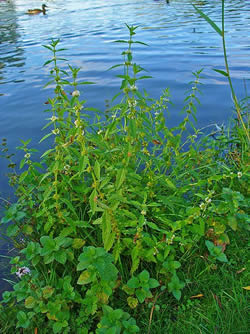Bugleweed Lycopus spp.
- Common Names
- Bugleweed , Water Horehound, Gypsywort
- Botanical Name
- Lycopus spp.
- Family
- LAMIACEAE
Medicinal Uses & Benefits of Bugleweed
![]() How to Use|
Side Effects |
Plant & Garden|
How to Use|
Side Effects |
Plant & Garden|
- Medicinal Uses: * Female Hormones
* Pet
- Properties: * Antioxidant * Antitussive * Astringent * Cordial * Diuretic * Nervine * Vasoconstrictor
- Parts Used: Aerial parts: leaves, stems, flowers
- Constituents: phenolic acids: (caffeic, rosmarinic, chlorogenic, and ellagic acids); pimaric acid methyl ester
How to Use: Bugleweed
Bugleweed is a specific for overactive thyroid, especially when symptoms include shortness of breath, palpitations, and shaking. 1 The lithospermic acid in bugleweed is believed to decrease levels of certain hormones, especially the thyroid hormone thyroxine (T3). This compound also keeps antibodies from binding to and "burning out" cells in an overactive thyroid gland. By moderating estrogen levels, bugleweed relieves cyclic breast pain in women. 2
The nerve calming and vasoconstrictor actions of bugleweed make it useful for pain relief in situations that involve irritability and tension. It does not contain salicylates, so it can be used for pain relief in those with sensitivities to them. Bugleweed is especially useful in cats with overactive thyroid conditions. 3
Preparation Methods & Dosage :Teas, and less frequently, tinctures and encapsulations. Combined with gromwell and/or lemon balm to treat thyroid disease. 2 Check with your vet for the right dosage for cats.
Bugleweed Side Effects: Like other mints, bugleweed is safe when used sensibly. Exceeding recommended doses of Bugleweed might cause a potentially harmful decrease in thyroid function; however, long-term use of bugleweed is considered safe for people and animals with hyperthyroidism. Not for use in those who are pregnant or nursing.
Plant Description
L. americanus is the more common bugleweed in North America and is most often found in stream banks and marshes being a lover of shade and plentiful water. Bugleweed is part of the mint family and is also known as water horehound and gypsywort, but does not have a minty odor. Bugleweed is a perennial plant, its creeping runners produce rosettes of leaves, the whole plant forms a carpet like mat and it is often used as a groundcover. Bugleweeds usually have shining oval shaped leaves that are close to the look of spinach leaves. The flowers are blue, pink or white and grow in whorls in the leaf axils.
Regional Traditions :European * North America *
Related Species Lycopus virginicus (Virginia water horehound), L. europaeus (gypsywort) , L. americanus (American water horehound)
History and Traditions & Folklore
 This herb belongs to Dame Venus. If the virtues of it make you fall in love with it (as they will if you be wise) keep a syrup of it to take inwardly, an ointment and plaister of it to use outwardly, always by you.
The decoction of the leaves and flowers made in wine, and taken, dissolves the congealed blood in those that are bruised inwardly by a fall, or otherwise is very effectual for any inward wounds, thrusts, or stabs in the body or bowels; and it is an especial help in all wound-drinks, and for those that are liver- grown (as they call it.) It is wonderful in curing all manner of ulcers and sores, whether new and fresh or old and inveterate; yea, gangrenes and fistulas also, if the leaves bruised and applied, or their juice be used to wash and bathe the place; and the same made into a lotion, and some honey and alum, cures all sores in the mouth and gums, be they ever so foul, or of long continuance; and works no less powerfully and effectually for such ulcers and sores as happen in the secret parts of men and women.
This herb belongs to Dame Venus. If the virtues of it make you fall in love with it (as they will if you be wise) keep a syrup of it to take inwardly, an ointment and plaister of it to use outwardly, always by you.
The decoction of the leaves and flowers made in wine, and taken, dissolves the congealed blood in those that are bruised inwardly by a fall, or otherwise is very effectual for any inward wounds, thrusts, or stabs in the body or bowels; and it is an especial help in all wound-drinks, and for those that are liver- grown (as they call it.) It is wonderful in curing all manner of ulcers and sores, whether new and fresh or old and inveterate; yea, gangrenes and fistulas also, if the leaves bruised and applied, or their juice be used to wash and bathe the place; and the same made into a lotion, and some honey and alum, cures all sores in the mouth and gums, be they ever so foul, or of long continuance; and works no less powerfully and effectually for such ulcers and sores as happen in the secret parts of men and women.
Nicholas Culpeper, 1653
- Hoffmann, David (2010-12-15). Medical Herbalism: The Science and Practice of Herbal Medicine (pp. 563). Healing Arts Press.
- Mountain Rose Herbs
- Tillford, Gregory. "Herbs for Pets", 2001, BowTie Press ,p84













